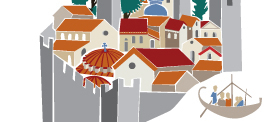The walls
The first fortifications around the settlement have
been dated to the mid 4th century. They included a five-sided
citadel and a wall surrounding the south-west part of the hill. Access was
gained via two gates: a main gate with a narrow postern in the west part of the
wall, and a secondary one
in the south
section. Inside the
castle, investigations have brought to light two small underground water cisterns,
one at the base of a tower next to the north-west corner of the wall and
another in the citadel, which provided water for the small fortress guard.
These initial defences were reinforced at least four
more times in subsequent periods. In the reign of Justinian the
fortifications were built higher, and a semi-circular tower was added to the
south branch of the wall. It was then that a large water tower was erected in
the open, flat part of the citadel. The settlement was founded when the seat of
the bishopric of Litis was transferred to Rentina in the 10th century,
at which time rectangular towers were added to the corners of the walls around
the citadel and the lower city, and at other vulnerable points that needed
bolstering. At the same time a triangular wall was built around part of the
hill from the eastern side, running along the rocks on the brow. There do not
appear to have been any buildings inside the east wall, which was probably used
to protect the residents’ flocks in times of siege. The inside of the keep was
full of wooden frames between layers of earth, which have been dated to c. 980
A.D. by the carbon 14 (C14) dating method.
A roofed semi-underground corridor started at the base of tower and led to an
underground water tower with a double antechamber, which had a corbelled dome
ceiling. The tower gathered water from a nearby stream, and was used either to
store drinking water or as an underground workshop for the production or storage
of useful or precious products.
As it was built on a steep incline, the tower did not
last long; it was abandoned in the 12th century along with two
sections of the eastern wall. From then on the east side of the hill was
protected by two powerful walls running down to the bottom of the hill behind
the citadel. These were strengthened with stone facing in a subsequent period.
It was probably then that the south wall gate was blocked up for greater
safety.
After 1204 the Franks strengthened the citadel wall by
repairing the northern rectangular tower and the north exterior surrounding
wall, which had been founded at a relatively unassailable point. After the
castle was taken by John Vatatzes and his army (1242), a new keep was built to
the east of the citadel, at the intersection of the two strong double walls running
down to the side branches of the initial east wall. This was designed to protect
both the guard and the inhabitants. The walls and the entire settlement were
abandoned after the mid-14th century.
Glossary (1)
cistern:
reservoir for collecting water. Usually rectangular in shape and roofed with arches.
Information Texts (1)
Justinian I:
Byzantine Emperor
(527-565), nephew and successor of Justin I. One of his first acts was to
reform the tax system and recode Theodosius’ laws. He was personally involved
in religious conflicts and convened the 5th Ecumenical Council
(553). Justinian considered himself primarily an orthodox emperor and took
harsh measures against the remaining pagans. Many of his political and fiscal
actions provoked strong reactions on the part of the senate and the factions
and led to the Nika Riots. Justinian instigated numerous building projects,
erecting approximately 30 churches in Constantinople,
including the famous church
of Agia Sophia.
Regarding foreign policy, he successfully confronted the Persians and the
Vandals in the East and focused on the recovery of the West. This he temporarily
achieved, but at such cost that the Empire was left exhausted; the barbarians in
the Balkans plundered the Greek peninsula as far as the Isthmus and barbarian
tribes settled at the borders. His military operations exhausted Byzantium financially and
militarily and had no real effect, as Italy and other areas he conquered
were soon lost again. After his death, the weakened empire had to face new
attacks, culminating in the Arab conquests, which negated the majority of
Justinian’s conquests beyond the borders.
Bibliography (3)
1. Μουτσόπουλος Ν., Ο βυζαντινός οικισμός της Ρεντίνας, 1996
2. Μουτσόπουλος Ν.Κ., Ρεντίνα ΙΙ, Το Βυζαντινό Κάστρο της Μυγδονικής Ρεντίνας, Η οχύρωση και η ύδρευση του οικισμού, 2001
3. Μουτσόπουλος Ν., Κοσμική αρχιτεκτονική στα Βαλκάνια 1300-1500 και η διατήρησή της, Thessaloniki, 1997
Comments (0)





